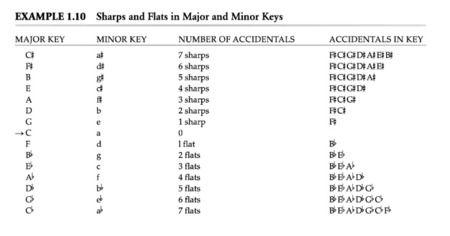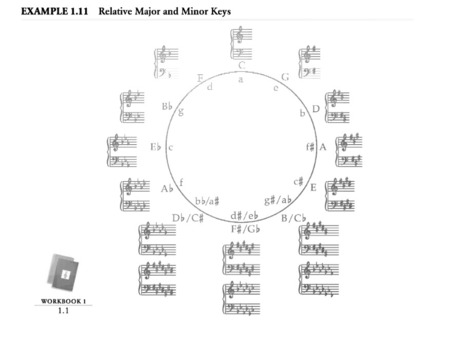The Circle of Fifths is a mnemonic tool used to memorize which notes are a perfect fifth1 away from a given note. The Circle of Fifths is also helpful for figuring out which notes are sharp or flat in a given key.
The first diagram below2 lists all of the major keys, their relative minor keys3, and the notes that are sharpened or flattened in that key.
Each time you go up the chart in the direction of the sharps starting from C major, another note gets added to the list of sharpened notes in that row's key. The mnenonic I use to memorize the order of the notes that get sharpened is:
Fidel Castro Gets Drunk At Every Bar.
This mnenonic captures the order of the tonics as they ascend from F in the Major Key column, excluding the top two tonics: F# and C#. If you are in the Major key of one of the notes enumerated by the above mnenonic appended by F#, C#4you find the sharps in the key by sharpening the notes starting from F up to 2 indices down your current key's tonic's position. (i.e. A is the 5th note in the list so the sharps are F#, C#, and G#. We stop at G because G is 2 down from A)
This trick does not work for F Major, which has just 1 flatted B, nor for C Major, which has no sharps nor flats.
As you go down the rows from C Major, the notes in the keys get flattened. The (popular) mnenonic I use to remember the order of the notes that get flattened is:
BEAD GCF (Greatest Common Factor.)
If you are in any of the flattened Majors keys, to acquire the notes that are flattened in that key you list the notes in the mnenonic up to one index greater than the position of your key's tonic. For example, A is the 3rd note in the mnenonic so the notes flattened in Ab Major are all those up to and including the one in the 4th position: B,E,A, and D.
***
There are 12 pitch classes, and thus there are 24 possible keys (1 Major and 1 minor key for each pitch class). Yet this chart has 15 rows, so there is redundancy with three pairs of Major and minor keys whose respective tonics are enharmonic notes. Those pairs are
(C#/a# with Db/bb)
(F#/d# with Gb/eb)
(B /g# with Cb/ab)
This second graph, the Circle of Fifths itself, shows those pairs of keys. I believe that these three pairs of enharmonic keys are enumerated for the sake of making the nice pattern found in the first diagram. But I do not know the reasons why one would choose one key over another key from the above pairs - i.e. why would anyone consider themselves in Cb Major instead of B Major?
After writing these notes, I figured that I need a larger mnenonic for memorizing the full clockwise walk around the Circle of Fifths to be able to acquire the note that is a fifth away from my current note. I came up with:
Fidel Castro Gets Drunk At Every Bar, Gbod Dbamn Ablcohol Eberyday, Bbad Fidel...
I should eventually memorize F->C, C->G, G->D, individually so I don't have to "sing the alphabet from the beginning" to know the next letter. Likewise I should memorize the relative minor key for each major key, instead of walking back a minor third each time.
Anyways...next up, intervals!

